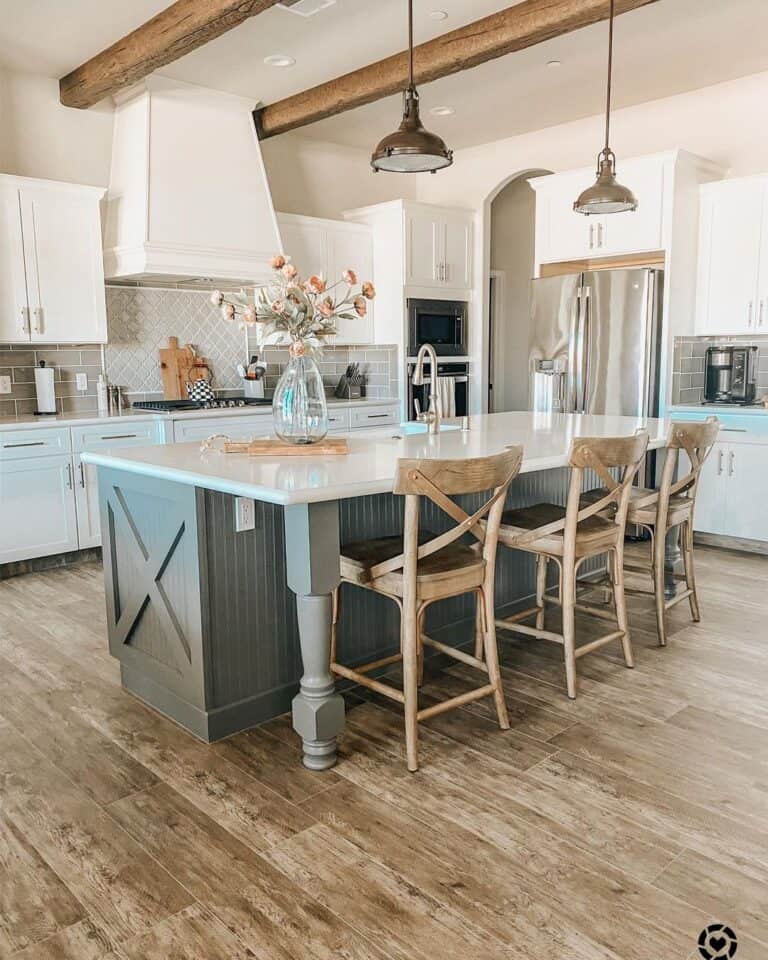Trick Considerations for Locating the most effective Legs For Kitchen Island for Your Style
When picking the excellent legs for your kitchen island, several vital factors to consider enter into play that can considerably impact both capability and appearances. The selection of elevation, design, and material need to align with your total kitchen area design to make sure a harmonious appearance. Additionally, security and maintenance needs are vital for long-term usage and ease of treatment. Understanding these variables can improve your cooking area's functionality and aesthetic appeal, yet the nuances of each factor to consider can often be forgotten. What implications might these options have on your kitchen area's total environment?
Determine Your Design Choice
Establishing your design preference is crucial when choosing the suitable legs for your cooking area island. The legs of your kitchen island not only serve a practical function however likewise add dramatically to the total visual of the room. Therefore, identifying your design style-- be it modern, rustic, traditional, or industrial-- is important.
For a modern cooking area, think about sleek, minimalistic legs that enhance open rooms and clean lines. Traditional cooking areas typically favor turned or luxuriant legs, which can include a touch of beauty and refinement.
Additionally, think about the elevation and percentage of the legs in relationship to the island's surface. Ultimately, your style choice will certainly affect not just the selection of legs but also the general harmony of your kitchen area's layout.
Pick the Right Product
Selecting the right material for your kitchen area island legs is essential in making sure both durability and aesthetic appeal. Various materials provide unique benefits, and the choice typically shows your style preferences and practical demands.
Wood is a prominent choice, offering warmth and flexibility. It can be stained or painted to match your kitchen decor, making it versatile to numerous designs, from rustic to contemporary. Timber might need regular maintenance to maintain its appearance and integrity.

If you look for a distinct touch, take into consideration acrylic or glass materials. They can produce an impression of space and agility in your cooking area, making them an outstanding selection for smaller sized areas - Legs For Kitchen Island. Nevertheless, these alternatives may need mindful handling and maintenance to avoid scrapes.
Eventually, the material you pick need to align with your kitchen area's general layout, ensuring that the legs serve both practical and ornamental purposes.
Consider Height and Percentages
When making a kitchen island, height and proportions play an important function in making certain capability and convenience. The basic height for a kitchen island usually ranges from 36 to 42 inches, aligning with conventional counter heights or bar heights, specifically. This measurement is crucial for balancing with surrounding counter tops and stools, making it possible for convenience of use during meal prep work and social communications.
Furthermore, the island's percentages need to match the overall kitchen area format. Consider the ratio in between the island's size and length, guaranteeing it offers ample surface area without crowding the kitchen.
In addition, the height of the legs or base can affect the visual allure and functionality. Taller legs might lend an extra modern, ventilated feel, while check this site out much shorter ones can evoke a standard, grounded appearance. Inevitably, thoroughly considering height and percentages will lead to a kitchen island that is both functionally reliable and visually attractive, boosting the overall style of the room.
Assess Stability and Toughness
A kitchen island's legs need to not just complement its height and percentages yet also supply ample stability and toughness to sustain daily activities. The legs are necessary to the total capability of the island, as they bear the weight of the counter top and any type of added loads, such as appliances or food preparation jobs.
When analyzing security, it is essential to think about the leg style and product. Sturdy metal or solid hardwood legs typically use remarkable toughness compared to lighter materials like engineered wood or plastic. Additionally, a larger base can enhance stability, decreasing the threat of tipping or tottering during use.
Sturdiness is similarly vital; the legs ought to resist wear and tear from everyday use. Consider coatings that shield versus scrapes, dents, and moisture, especially in a kitchen setting. Review the top quality article source of building, such as joints and fastenings, which can substantially affect the legs' long-term efficiency.
Eventually, investing in well-crafted legs that focus on stability and sturdiness will guarantee your kitchen island continues to be a trusted office for years ahead, improving your culinary experiences while preserving aesthetic allure.
Consider Upkeep and Care
Upkeep and care are essential considerations for ensuring the durability and performance of kitchen area island click here to read legs. When selecting legs, it is necessary to assess the products used, as various alternatives need differing levels of maintenance. Wood legs might require regular refinishing or sealing to protect against moisture damage and scrapes, while steel legs may need normal brightening to maintain their shine and avoid corrosion.
Moreover, the finish applied to the legs can affect upkeep needs. A high-gloss finish may be easier to tidy yet could show scratches and fingerprints much more easily than a matte coating. It is advisable to choose materials and surfaces that match your way of living; as an example, if you frequently organize events, select sturdy products that can withstand wear and tear.
Additionally, think about the cleaning process included in preserving these legs. Smooth surfaces typically need very little effort, while complex styles may collect dust and gunk, requiring more labor-intensive cleaning methods. Legs For Kitchen Island. Ultimately, considering the upkeep and treatment needed for your selected kitchen island legs will not just boost their visual charm however also ensure their useful honesty with time
Final Thought
Finally, choosing the optimal legs for a kitchen island demands cautious consideration of various factors, consisting of design style, material selection, upkeep, height, and security. Each aspect plays an important role in making certain that the legs not just enhance the visual charm of the kitchen yet likewise provide the needed support and toughness for day-to-day use. A well-informed choice will ultimately add to a practical and aesthetically pleasing kitchen area setting.
The legs of your kitchen area island not just serve a useful function yet likewise add substantially to the overall aesthetic of the room.Maintenance and treatment are vital considerations for making sure the longevity and performance of cooking area island legs. Wooden legs might call for regular refinishing or securing to prevent wetness damages and scratches, while metal legs might need routine brightening to maintain their luster and protect against rust.
Eventually, factoring in the upkeep and treatment required for your selected cooking area island legs will not only improve their aesthetic allure yet also guarantee their useful integrity over time.

 Alfonso Ribeiro Then & Now!
Alfonso Ribeiro Then & Now! Ariana Richards Then & Now!
Ariana Richards Then & Now! Brian Bonsall Then & Now!
Brian Bonsall Then & Now! Robbie Rist Then & Now!
Robbie Rist Then & Now! Lynda Carter Then & Now!
Lynda Carter Then & Now!